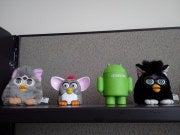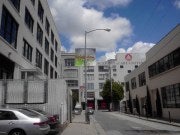Another day, another 4G handset on Verizon. The LG Revolution ($250 with a two-year contract with Verizon; price as of 5/27/11) joins the HTC Thunderbolt and the Samsung Droid Charge as the third LTE device on Big Red. How does it stack up to the other two? While the Revolution is attractive and solidly built, the overlay LG slapped over Android isn't the slickest. I wished LG would have kept the straight Android, like the T-Mobile G2x.
Sturdy, Attractive Design
I first caught a glimpse of the LG Revolution at Verizon's big 4G kickoff at CES and was eager to get my hands on it. Measuring 5.03-by-2.63-by-0.52 inches and weighing 6.06 ounces, the Revolution is slightly larger and heavier than the Thunderbolt. For my small hands, it isn't the most pleasurable thing to hold up to my ear for a long amount of time. The Revolution is solidly built with black plastic around its borders and a rubberdized matte black battery cover with a silver strip running down the middle. Chrome stripes also line the left and right spines of the phone. The plastic below the display has sort of a "brushed" textured effect. It is a subtle detail that makes the phone feel more high quality.
Four responsive touch buttons like beneath the display: Menu, Home Back and Search. A chrome-covered (argh, not a fan of covered ports) micro-USB port is located on the right spine while a chrome-covered HDMI port (argh, again) and volume rocker can be found on the left spine. The 3.5-mm headphone jack and power/lock button is located at the top.
Like the HTC Thunderbolt and the Samsung Droid Charge, the Revolution has a 4.3-inch TFT display. With an 800-by-480-pixel resolution, the Revolution has the same resolution as the Thunderbolt and the Droid Charge. I did some side-by-side tests of images and video on the Thunderbolt and Revolution (see multimedia) and surveyed fellow PCWorld editors. Even though the phones have the same resolution, the editors unanimously agreed that the Thunderbolt had better colors and more clarity. The Revolution is incredibly difficult to see in bright sunlight, too. The screen gets quite smudgy, which adds to the bad outdoor visibility.
Clunky Android Overlay
The Revolution runs Android 2.2 (Froyo) with a custom-built LG overlay running on top of it. Mostly, the overlay behaves as native Android does. Dots running across your homescreen help you keep track of which homescreen you're on. Like HTC Sense, you can see thumbnail-sized versions of your homescreens by pinching out on any screen. From there, you can jump between them. Four icons consistently run below your homescreens: Phone, Contacts, Messaging and Apps.
For whatever reason, LG made the decision to slap its own software keyboard on the Revolution rather than the stock Android keyboard. Big mistake. The keyboard and autocorrect is incredibly frustrating to use. I made way more errors than I usually do on a stock Android software keyboard. The keys are too slim and the autocorrect seemed to be more incorrect than correct!
The Revolution's App Drawer is, well, kind of a mess. Preinstalled applications are organized by category: Communication, News & Search, Media, Tools, Applications (which is empty) and Downloads. You can't reorganize these apps either, which is annoying. Say you download an app, like Tweetdeck, for your Twittering purposes. By LG's classification, this should fall under Communication, right? Well, too bad, because it is going to get thrown into the "Downloads" section (right, not Applications. I don't get it either). You can't hold down and drag an icon to another section of your App Drawer either (that will actually make the app into a shortcut on one of your homescreens). I tried reorganizing my apps via the Manage Applications menu in Settings, but you can only uninstall or force stop apps there.
I appreciate LG trying to practice some kind of app taxonomy here, but the user should have some sort of control over where the app gets organized. It makes things just more disorganized. It is almost as if Verizon and LG don't expect you to download your own applications.
Speaking of preloaded apps, the Revolution is yet another Verizon phone with Bing Maps and Bing Search preinstalled. Pardon me while I rant for a second. I have nothing against Bing; in fact, I think some of the Windows Phone 7 Bing features look really cool. I just don't think it is fair to consumers who buy an Android phone and expect a full Google experience. What does Google do best? Search. What do you get when you try and search on the Revolution? Bing Search. It is the same story with VZ Navigator. Google Maps does not come preinstalled on the Revolution, strangely. You can of course download these apps, but it is kind of annoying that so many apps come preinstalled, but not these Android staples.
Multimedia
YouTube videos played back smoothly with no buffering, but again, the weaknesses of the Revolution's lower resolution display were apparent. I did a side-by-side comparison of the Thunderbolt, Samsung Nexus S (unfortunately, I had to return the Droid Charge) and the Revolution playing a Shepard Fairey clip on YouTube. I surveyed a few editors around the office who unanimously decided that the Revolution's video had less clarity and sharpness than the other two displays. You really have to look closely, however, to see the differences between the displays, however.
One notable feature about the Revolution is that it comes loaded with the brand new Netflix for Android app. I tested Netflix over both Wi-Fi and 4G. While video ran fairly smoothly over both, the video quality was fuzzy and colors looked washed out. Netflix is not yet supported on the Thunderbolt so I compared it to the Nexus S, which can use the Netflix app.
Camera and Gallery
 The Revolution's 5-megapixel took pretty decent pictures inside and out though it wasn't quite on par with other phone cameras we've tested, like the LG G2x or the HTC Droid Incredible 2's snappers. Colors were a bit washed out and details were more on the blurry end. The flash is quite powerful, which is great for very low light environments.
The Revolution's 5-megapixel took pretty decent pictures inside and out though it wasn't quite on par with other phone cameras we've tested, like the LG G2x or the HTC Droid Incredible 2's snappers. Colors were a bit washed out and details were more on the blurry end. The flash is quite powerful, which is great for very low light environments.
Video shot in 720p looked pretty good though it wasn't spectacular. The camera handled motion well, but again, colors look a bit washed out.
 The Gallery is pretty much the same as the native Froyo gallery. Your photos are grouped by whether they're saved on the internal memory or your SD card. If you have a Picasa account, your photos stored there will automatically be loaded into the account.
The Gallery is pretty much the same as the native Froyo gallery. Your photos are grouped by whether they're saved on the internal memory or your SD card. If you have a Picasa account, your photos stored there will automatically be loaded into the account.
Performance
While the LG-made T-Mobile G2X is powered by a dual-core NVIDIA Tegra 2 processor, the Revolution only has a single core Snapdragon MSM8655 processor. This is the same second-generation processor you'll find in the HTC Thunderbolt. While we've certainly been impressed with the Tegra 2 phones, the 1GHz Revolution handled games, browsing and multitasking perfectly well.
I tested the LG Revolution's 4G LTE data speeds using the FCC-approved Ookla Speed Test app in the South Park neighborhood of San Francisco. The Revolution got an average download speed of 7.14 megabits per second (mbps) and an average upload speed of 3.46 mbps. The average latency was 86 milliseconds.
Call quality was okay over Verizon's network in San Francisco. Voices sounded quite though crisp and clear with no static, hiss or other distortion. Callers on the other end of the line were quite pleased with my voice on the Revolution; they reported that my voice had an ample amount of volume and a natural tone.
We haven't had a chance to formally test battery life, but the Revolution's 1,500 mAh battery handled about five hours of heavy use on 4G before it needed a charge. It seems like the Revolution suffers from the same battery issues as the Thunderbolt and the Charge. And of course, there's no preloaded widget to switch off 4G; you have to either go into Settings or install a third-party widget. Once we do our formal testing, I'll update the review with the results.
Bottom Line
If you're looking for a phone to watch movies, do some heavy browsing and play games, you'll be satisfied with the LG Revolution. But in terms of how it ranks among Verizon's 4G phones, I'd have to put it in third place. The Droid Charge, while more expensive ($300), has a more superior Super AMOLED Plus display. The Thunderbolt, the same price, has a cleaner user interface and seemingly better display. The Revolution's interface is less polished, but its hardware is the most attractive of the three.
Source: http://feeds.pcworld.com/click.phdo?i=794c169ead72285423146ce476bf675b
tom hardy minneapolis bernard hopkins ken jeong john rich mary j blige justin bieber and selena gomez kissing
No comments:
Post a Comment
Note: Only a member of this blog may post a comment.